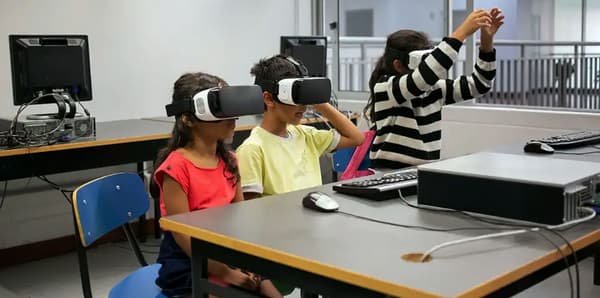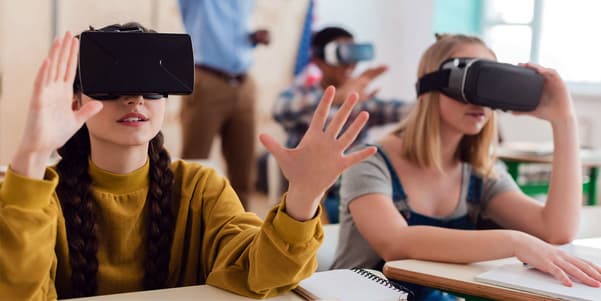The traditional classroom rapidly evolves, with new technologies reshaping students’ learning. Among these innovations, Virtual Reality (VR) stands out as one of the most promising tools for education. VR allows students to experience learning in a completely immersive environment, making lessons more interactive and memorable. As schools and universities increasingly adopt this technology, it’s clear that VR is more than just a trend; it’s a new way to learn.
What is VR in Education?
Using VR headsets and software, educators can create interactive lessons that go beyond traditional classroom methods, offering students a more dynamic and hands-on approach to learning.
How VR Integrates into the Learning Environment
VR technology can be integrated into the classroom in various ways, making learning more engaging and adaptable. For example:
- Virtual Classrooms: VR can create simulated classrooms where students can participate in lectures, discussions, and group projects, all while interacting in a 3D environment.
- Virtual Field Trips: Students can explore historic sites, distant landscapes, or even outer space, all from the comfort of their school.
- Lab Simulations: VR allows for safe, controlled simulations of scientific experiments or engineering tasks, offering a realistic experience without the risks or costs of real-life setups.
Types of VR Used in Education
VR in education can be divided into two primary types, each with distinct features:
- Immersive VR involves full immersion. It often uses headsets and hand controllers to transport students into a 360-degree digital environment. This provides a more intense and engaging experience, allowing users to move and interact freely with virtual elements.
- Non-Immersive VR: This approach is less intensive and involves desktop or tablet-based applications where students interact with a virtual environment on a screen. It’s more accessible and cost-effective, making it popular for schools with limited budgets.
VR as a Tool for Enhanced Learning
The core idea of using VR in education is to create experiential learning opportunities. With VR, complex concepts can be simplified through visual aids, making it easier for students to grasp challenging topics. For example, medical students can perform virtual surgeries, language learners can engage in virtual conversations, and history students can relive historical events as if they were there.

Key Applications of VR in Education
VR technology offers diverse applications across various educational fields, making learning more interactive, engaging, and effective. Here are some of the most impactful ways VR is transforming education:
STEM Learning
- VR provides a safe and immersive science, technology, engineering, and math (STEM) education environment.
- Students can perform complex experiments in virtual labs, such as observing chemical reactions or building electrical circuits, without any safety risks or resource limitations.
- In engineering, VR helps visualize architectural designs, test mechanics in real-time simulations, and understand spatial concepts more intuitively.
Medical Training
- Medical schools use VR for simulations that allow students to practice surgeries, diagnose illnesses, and understand human anatomy in 3D detail.
- VR tools like Touch Surgery and Osso VR provide real-world scenarios where medical students can enhance their skills without the pressures or risks associated with live patients.
History and Geography
- VR takes history lessons beyond textbooks by letting students explore historical events, sites, and cultures through immersive experiences.
- Students can visit ancient ruins, walk through medieval castles, or experience pivotal historical moments, making lessons more vivid and memorable.
- In geography, students can take virtual tours of natural landmarks like the Grand Canyon, the Great Barrier Reef, or even volcanoes, deepening their understanding of global ecosystems.

Challenges and Limitations of VR in Education
| Challenges | Description |
| High Costs | Expensive equipment and maintenance limit adoption, especially in underfunded schools. |
| Limited Access | Lack of infrastructure and poor internet connectivity hinder VR use in certain areas. |
| Technical Issues | Prone to glitches and requires regular maintenance, which can disrupt lessons. |
| Motion Sickness | Common among users is limiting session duration and effective use. |
| Need for Teacher Training | Teachers need training to integrate VR, which can be time-consuming and resource-intensive. |
| Content Gaps | Limited curriculum-aligned content for certain subjects. |
| Privacy Concerns | Concerns about data collection and the need for strict privacy measures. |
Despite its potential, VR in education faces significant hurdles, including high costs, limited access, technical issues, motion sickness, and the need for teacher training. Additionally, gaps in curriculum-aligned content and privacy concerns present further challenges. Overcoming these barriers is essential for broader VR adoption in learning environments.